Review GSM phone Motorola ROKR E2 – interface and business functions.
Motorola ROKR
E2. Live pictures
Motorola ROKR E2.
Part I
Motorola ROKR E2.
Part 2
Motorola ROKR E2.
Part 3
Motorola ROKR E2.
The last part
Considering the pre-history of appearance of the ROKR E2, its configuration,
hardware filling we can turn to the peculiarities of its interface
and realization of some functions. I will remind you, that the ROKR
E2 is one of the first handsets with UI Chameleon, interface version
– 3.1. This interface will be the basic one for JUIX handsets which
do not have the sensory display. It is basic in the E2; while the
new handsets are produced the UI versions will change and its functionality
will be increased.
One can see the difference of the interface from all famous Motorola
products just while looking at the display in the standby mode.
The operator logo is shown under the service line at the left side;
this location is determined by reserving of space for the speed
access icons. Speed access icons are not fixed strictly, they can
change in size, move along the display. Their behavior depends only
on the appearance of extra information, for instance, the information
about the current composition, visual displaying of controlling
elements of the player. Under the line with the operator logo there
is textual information about the current working mode, for instance,
there can be the inscription «Bluetooth», «GPRS» or something like
that. The inscriptions double the icons in the service bar.
 
Like triplets, the user can choose analog or digital clock, which
are available in the display in the standby mode. One can set different
functions for joystick inclinations; they can be chosen from the
list. Besides standard functions, one can choose applications set
on his own. It is possible not to show icons in the display, thus
they will be hidden.

The item Options conforms the left soft button, it activates camera
(it is logically, because there is no handset button), creates messages,
changes profiles and finally sets the display view in the standby
mode.
The menu navigation is very simple; entrance to the menu is made
by pressing the joystick; exit to the higher level menu is made
by the key «Ñ» (there is an arrow on it, the symbol of return).
Unfortunately, it is not possible to return to the previous level
or cancel just made action with the key «Ñ» in all menus; sometimes
one should enter context menus, it is often inconvenient and breaks
the integrity of the handset ideology. Evidently the work for improving
or removing this imperfection will be continued in future. Frankly
speaking, this problem is not so big and shows up only while active
using the handset in all modes.
On default it is possible to turn on the mediaplayer, to change
the current profile to silent mode and backward from the keyboard
by one touch. One can set speed dials to the digital keys, while
they can be chosen either from the phonebook memory or put independently.
Interface,
videoclip (wmv, 3,39 Mb)
Voice functions. At the right sight there is an
access key to the voice functions. In the standby mode it is responsible
for number dialling or entering the commands. There is voice recognition
in the handset which does not depend on the accent of the talker.
It does not require the prior voice training; the handset apprehends
majority of commands without any problems. Particularly, it is possible
to dial the number from the phonebook, it is enough to indicate
the name and the last name, and then indicate the type of the number
– office, home, fax, etc. The list of the commands is quite wide:
from voice dialling to activation of some menus or checking battery,
checking status. In the last case the handset informs aloud the
charging level per cent or the signal level. The function is pleasant
and sometimes becomes useful, especially when using the headset.
Pressing the headset button in the standby mode is similar to the
voice key action. In other words, one can manage the handset without
taking.
 
The similar system of voice dialling one can see in the current
models of Motorola; in the E2 expansion took place because of the
new commands, but this function is not noted for principle originality
till one can see its integration with the Talking phone. In the
menu Settings for some menu items one can choose reading out of
its names, information in the sections by the handset.

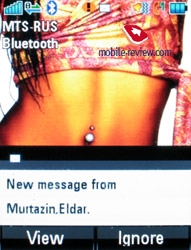
For instance, one has received the message. Besides the message
signal, the handset is capable to read out the number of sender,
his/her first name and the last name if he is known. When open the
message, the handset reads out its contents aloud. In some cases
when one has the handset in front of him, this function is not relevant;
but while driving the car, jogging or something like that it can
be interesting. The voice of synthesizer is male, texts in English
are read out quite acceptably; one can catch the sense with ease.
Unfortunately, it is difficult for the handset to read phone numbers;
it tries to interpret them as numbers, thus in verbal presentation
of seven-place numbers there are millions; that is confusing. It
is reasonable that the handset does not apprehend any abbreviation;
it reads them out letter by letter, and that causes troubles while
listening. All words written in capital letters are apprehended
as abbreviations and read out letter by letter. It is possible to
set the work of voice reader for messages, e-mail, received calls
(i. e., when calling the name is read out), reading the menu items
(when navigating along the menu the chosen item is read out; it
is not functioned in the menus of the third level). It is curious,
that in the menu for one's items their readout is active in such
way as for standard ones. At last, while navigating along the name
list in the phonebook they can be read out aloud, as the numbers
while dialling from the keyboard, though. If one dials numbers fast,
the function can miss some numbers and can be switched off. It is
pleasant, that the readout settings are different for every item;
the user can set them as he wish.
Voice
functions, videoclip 1 (wmv, 4,8 Mb)
Voice
functions, videoclip 2 (wmv, 8,2 Mb)
The main menu of the handset is presented by the matrix 3 x 3,
but can consist of larger amount of items; then the scroll bar appears.
The icons of the main menu are animated, they look interesting,
though the quality of design is not as good as in the handsets of
SonyEricsson; while at the same time it is progress in comparison
with the current models of the company. The view of the main menu
can be turned to the text mode, then the icons disappear and all
items are shown as lists. In absence of graphic design, this presentation
is not really bright, monotonous; it seemed uninteresting to me.
 
All submenus are presented by lists. Digital shortcut number navigation
is available. And the most interesting ability of the handset is
that while setting up applications one can put their icons at the
main menu; then they will be one of the items. And moreover, there
is a possibility to create one's own folders – the choice of icon
and input of the appropriate name for it. In such folders one can
put either applications or any files. In any folder one can create
his folders; the options are similar. The order of items is defined
at random, and however in the main menu it can be set at one's own,
though. There is also a possibility of icon choice for standard
folders.
Text input, personal dictionary. The arrangement
of work with text in this model is a result of development of intellectual
iTap input. Particularly, while word guessing automatic filling
and the most probable word combinations are offered; it allows not
inputting the word entirely. This function works well and allows
writing messages fast. The words the phone does not know are stored
automatically after the first input and offered along with the combinations
from the dictionary. At the same time the user can put its own words
in the dictionary in forced way. To provide security the dictionary
activation occurs using password (the password input is required
in the menu Settings when activating; it is an occurring once action).
 
 
 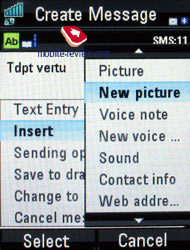
 
When text input up to 5 modes can be combined, its turning is assigned
with the key #. The sequential pressing the key # pages all modes.
The user chooses the order of those modes, for instance, the first
one is an intellectual text input, after that there is a literal
one, etc. It is important, that an automatic word filling works
also when literal word input; it makes life easier. The defect of
this model is long time of symbol substitution. While literal input
if the symbol from the same key is required one should use cursor
to remove elimination of the symbol put earlier. If one does not
do it, it will disappear, and it is reasonable. After the input
finishing and when changing the field such things sometimes happen:
the last put symbol was eliminated and it disappears from the display.
This peculiarity of the handset is unpleasant; one should adapt
to it.


Multitasking. The handset completely corresponds
to contemporary phones in such characteristic; while music playing
back in the background mode one can work with other applications.
The pleasant peculiarity is storage of the last status for standard
functions if one has escaped not using the key « Ñ » but using the
Off button. For instance, in messages while typing one can press
the Off button, activate the menu Messages from the main menu –
and one is in the typing mode again and can see the last created
text.
The phonebook. Till recently the handsets of Motorola
differed a lot in design of the phonebook from all manufacturers
presented in the market. The first step to unification of the phonebook
was Motorola V3x; in the E2 one can see the result planning by the
company for all models.
 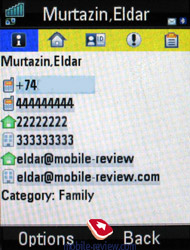
When input the new name one has 5 bookmarks with different information.
The first one is used for input of First name, Last name and also
up to 4 phone numbers (5 numbers are presented – mobile, office,
home, fax, other). Limitation in types is determined by realization
of the voice dialling which does not depend on the voice of talker.
For one name it is possible to input two e-mail addresses and to
choose their type. Finally, in this bookmark one can put the Instant
Messaging number; it can be the ICQ number, for instance. In the
phones of Motorola one should use Yamigo service, it is compatible
with ICQ, AOL and works without special problems.
The last item is the choice of the caller group, on default there
are 4 groups. One can create an unlimited amount of groups (no less
than 20), for every group one can choose picture, call alert, message
alert (any file).
 
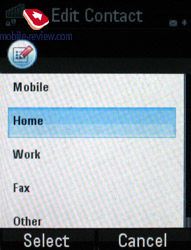 
The second bookmark is an address; there one can put postal address,
city, state, postal code, address type. The handset supports up
to two whole addresses with all fields.
 
The third bookmark is a personal photo or picture for caller. When
calling the picture is shown almost along the whole display.

The forth bookmark is a choice of call alert and message alert
for caller. They are priority within the alerts set for groups.
An interesting item is Privacy: if marked the note, it will be protected
from copying to PC; it will be visible in the general list. One
can activate the general protection of the handset; then the access
to the phonebook becomes possible only when entering the password.
 
The fifth bookmark contains various extra information, for instance,
text or voice note. It is possible to put the manager's name, the
assistant's name, URL, nickname, Spouse, the field "Children".
The field Birthday allows to note if the reminding is required;
it is possible to choose a period for it (from one day till the
event to two weeks). The field Anniversary is similar and also has
the warning.
 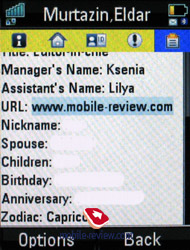
 
 
In the general list names can be presented only by the first name
and the last name, at the right side there is an icon on default.
Side scrolling allows moving along all numbers till the specific
name. First name or last name search is active, it depends on the
type of view chosen. One can set sorting of the list at the handset,
it will be re-formed in real time (either by first name or last
name).
In the name with icon displaying mode besides the first name and
the last name the number on default also displays.
As a storage for contacts one can choose either SIM-card; phone
and SIM-card or only phone. The using of the third variant is defensible.
The copying of all notes to SIM-card is supported (the name with
several notes divides into several notes).
 
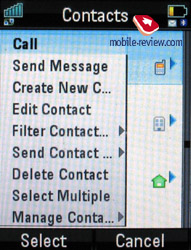 
From extra possibilities the remarkable one is the possibility
to put one's business card, it is a separate item in the menu. Navigation
in the general list seems to be slow; it is mainly caused by tracing
of moving. At the same time the comparison of moving time, activation
of any name shows that the handset is not so slow and can be compare
with other contemporary models.
The unique function of the phonebook is the option Most Frequent
Contacts. In the general list it is enough to activate such presentation
of menu as sorting. All the contacts looked through recently will
be put above, the list below will be regular and there will be all
names. The function is convenient, especially for those who have
more than 300 contacts.
On the whole the design of filters is convenient, one can turn
on the displaying of only SIM-card, the choice of any group, the
sorting along e-mail addresses and also Most Frequent Contacts.
Unfortunately, one can do it only from the context menu, the switching
using symbols * and # does not work, when pressing them the search
activates.
Synchronization with PC does not cause any troubles, all fields
spread correctly along the phonebook. Moreover, the acceptance of
the phonebook from other device via Bluetooth also works without
any difficulties. This function was tested with SonyEricsson K750i:
it took nearly 7 minutes to transport almost 400 names with fields
filled more than half, and its indexation took nearly 3 minutes
(visually all contacts from the first one to the last one are paged
in the display). Only standard information is transported; graphics,
alerts are not transported.
 
In the general list one can mark either the individual note or
several ones. All of them can be transported to other device via
Bluetooth. The interesting thing is blocking some contacts, it saves
one either from an accidental delete while synchronization (if the
replacement of contacts for ones from PC is set up), or from editing
contacts by malevolent people.
The handset supports the distant synchronization of the phonebook
with the server Exchange ActiveSync. It is enough to indicate the
variant of synchronization and behavior of the handset and input
settings of the server. The general volume of the phonebook is no
less than 1 000 names with all fields filled.

The phonebook design in the E2 is closed to ideal. It combines
the large amount of fields, flexible settings and filters. Unambiguously
winning in working convenience between the current models of Motorola,
the handset exceeds almost all common phones, including Siemens,
which is so attractive for users because of its phonebook. Being
inferior in amount of fields to smartphones on Symbian this model
wins in convenience of input organization and information review.
For those who have necessity to put more than 4 numbers to one name
this handset is not suitable. Really, no one has such a need except
students and extremely small amount of businessmen who compose nearly
2 – 3 per cent from all users.
Messages. The amount of messages in the memory
of the handset depends on the volume of the free memory. This model
has the standard structure of folders, and one can create its own
folders. In front of the folder the total amount of inbox messages
and the amount of unread messages is shown. While looking through
the list of every folder this data is also shown above.
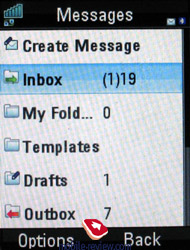 
 
The work with SMS/MMS messages is unitized at most. While creating
message one cannot see any difference between those two types of
messages. But it is enough to paste video or photo in the text,
and the inscription SMS will be changed to MMS in the service line.
It is quite logical, though it was mostly designed for users with
an intermediate level of training, thus the handset itself.
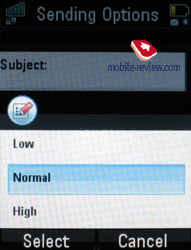 
 
 
While text input one can see the number of entered symbols in the
service line above. There is an EMS support, however, there are
no smiles or pictures prepared especially for this standard. There
are templates, they are separated: textual ones for SMS and individual
ones – for MMS. For text messages there are delivery confirmation,
read confirmation, it is possible to put the priority of message.
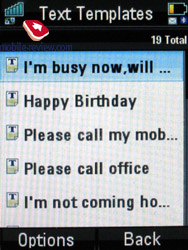 
 
 
The volume of MMS is free, in our case the handset sent easily
the message of 2 MB. As an MMS template there is the standard Postcard
in the handset; it is an MMS, assigned for a following print by
the addressee. Usually it is designed as a postcard: from the first
sight there is a picture and there is text from the other one.
 
 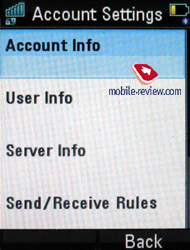
 
 
 

Mail client supports work with POP3/SMTP-servers, it is possible
to create several profiles. Message volume is not limited (but one
could not accept message of more than 3.5 MB volume because of timeout),
attachments of all file extensions are supported. While mail checking
it is possible to set a defined period, and also indicate, if the
whole letter, only its title or first 1, 5, 10 KB of it are downloaded.
Mail client is pleasant; it is comparable with those of regular
phones and offers a slightly more amount of settings. It is reasonable
that the handset is inferior to smartphones in abilities of working
with e-mail.
Office tools. This menu combines several functions,
in particular there are organizer, to-do list, notes, calculator,
file manager, download manager, world clock, MOTOSYNC. Access to
e-mail also doubles in the menu. Let's look through organizer first.

Calendar. Traditionally there are three types
of displaying – month, week and single day. In the calendar during
one month (view on default) one can see events for some days, they
are shown with stripes and correspond to load of the day (location
of lines in the display). In the view of the week there is a temporal
network and one can see his business load by visual demonstration.
Accordingly, in the day review there is also a temporal network.
In the settings it is possible to turn only to the actions located
in chronological order. The user can choose which type of the calendar
will be displayed on default. In the whole, the amount of settings
is large; one can choose the day which the week begins with; it
is possible to indicate how many days there are in the week for
one – 5, 6 or 7. One can choose the step of splitting for temporal
networks (from half an hour to 3 hours). It is possible to indicate
the time of the day beginning and the day ending when week or day
displaying (if the temporal network is indicated there). At the
first sight, the settings are simple, but they allow setting organizer
to be convenient for one's working day and needs.


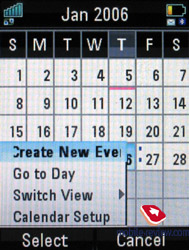 

New events in the calendar are put at the same style as in the
phonebook; there are four bookmarks. In the first one it is possible
to choose the type of event (12 different types, from ordinary lunch,
dinner, breakfast to presentations, flights, vacation); all events
have their icons in the list, which makes it quite different. The
following fields are accessible: name of the event, location, event
for the whole day (one can mark this item), choice of the profile
during the event (on default there is the current profile). Naturally,
it is possible to set the time for input event, to choose alarm
from one minute before the event to one week before it. If one does
not like preset variants of periods it is possible to sets one's
own one from one minute to ninety nine minutes. The signal alert
can be taken by the handset from the current profile or set individually
for any event.

 
 
 
 
 
The second bookmark is a text note for the event.
 
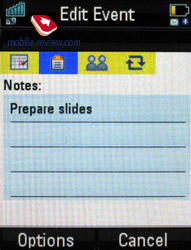
The third bookmark is unique as it is possible to indicate attendees
to the event. For instance, one can put the name of organizer and
his postal address (on default it is one's address); in the next
field one can put the names of attendees of the presentations, for
instance. When choosing their e-mail addresses from the list or
putting them one can immediately send them all the details of coming
meeting. The time of the event can be shown as free, busy, out of
office or extremely important. Another characteristic is also accessible
for input: the event is personal, private, confidential. The displaying
of the event in the list will be depended on setting this characteristic
and general settings of security.
 

The forth bookmark allows setting the repeat pattern. The repeat
pattern can be daily, weekly, monthly, yearly. When one has determined
the repeat pattern it is possible to put extra parameters, for instance,
the amount of weeks the event will occur (every x weeks, i. e. every
second week, for instance, if 2 is put). There is also a duration
limit: it is enough to indicate the date till which the repeating
will occur. For weekly repeat pattern it is also possible to choose
the separate day when the event occurs. When monthly repeat pattern
it is possible to choose the first day of the month or, for instance,
the alarm on the first Wednesday of the coming month. It is very
convenient for some events. The repeat patterns of the handset will
satisfy the most captious user. The authors consider that when month
displaying it is unnecessary to show the repeated events for every
week or every day; they are shown only in the week view or day view.
It is logically, as one remembers every day events without reminding.
 
 
 
Synchronization with PC causes no troubles, data can be ported
well either from the phone or to it. The separate events in the
form of vCard notes can be sent to other devices via Bluetooth.
The already created events can be entirely copied to other days,
it is enough only to put the date.
To-do list. These notes are very simple: one
should put the name, the date of ending (if necessary), status (the
complete action, but it is not necessary primordially), priority
(normal, high, low), at last, text note. Unlike organizer, there
is no alarm, and this is logical, as there are actions, not events.
Accordingly, it is not possible to copy an action to the organizer,
they are incompatible.
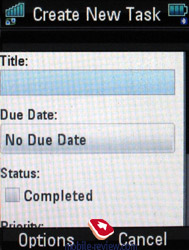 
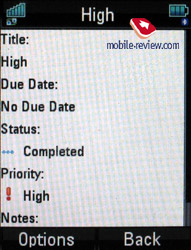 
 
 
 
It is possible to set sorting on the time of action ending, on
the fact if it is completed or not. To-do notes can be sent to other
devices with the assistance of SMS or via Bluetooth.
Notes. It is possible to put standard text notes,
from extra options there is a flag note in front of note, this is
only its accentuation in the list, there are no other functions.
Notes can also be sent to other devices with the assistance of SMS
or via Bluetooth. The note extension in the handset is not txt,
but it is the extension of which they are sent to other devices,
the convertation occurs at the moment of transfer.
 

Calculator is quite standard, it functions without
problems.
 
World clock function is realized quite well, besides
the map which has become standard one can choose the mode of comparison
up to three cities; then the time for every city will be displayed
in each line, it is convenient.
 

MOTOSYNC. There is so-called Exchange ActiveSync
which allows distantly synchronize data of organizer, phonebook
and also mail program. There are also SyncML settings, everything
is quite transparent.

File manager. The file system
of the phone is closed, so one
has to be content with the existing idea. In particular, in the
directory My files there are folders Pictures, Videos, Voice Note,
Application Downloads, My Blog, Music and Sounds, Unrecognizable
Files (in this folder there are all files which were not recognized
by the handset, in future one can transfer them everywhere he wants),
My Documents, Contact Images (as it is not difficult to understand
– photos associated with names), SD (access to memory card).
 
 
 
There is no concept of joint memory in the handset, memory card
acts as separate storage to a greater extent assigned for music,
photos than for any other files. In many respects the research of
multimedia files and index updating are realized in the handset.
There is logic in this solution, but it is unusual for the majority
of users and they have to get accustomed to it.
In the folder My Documents there is a number of folders; references
to network resources and messages of IM-manager are stored there.
 
 
 
Displaying in the form of list, list with details, list with preview,
icons are supported in every list. Separate files (or one can choose
some necessary ones) can be copied to memory card, copying of separate
folders (function SendTo) is supported. Sorting of lists in name,
date, size, type is supported. The
work with files, videoclip 1 (wmv, 6,75 Mb)
It is curious that there is a special icon for txt-files, and in
the mode of list with preview the first line is shown in viewport.
I. e., there is a possibility of working with txt-files in the handset.
Moreover, there is also the same possibility for pdf-files and MS
Office, but it is closed.
The speed of copying to memory card is very high, there are no
troubles in it. When copying separate files it is not possible to
choose directory of destination, they will be put to the root directory
of the card. It is not quite convenient.
There are 16 MB of memory accessible for user, it is possible to
watch the volume of accessible memory from the main menu when activating
context menu. It is convenient, that there is a several items splitting,
one can see which application takes more memory. This volume is
quite enough for storing of photos associated with the names from
the phonebook, signal alert and message alert (though the latest
ones can be stored in the memory card).
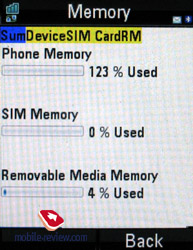 
 
File manager of this handset is aligned to standard users which
does not correlate with the general functionality of the model.
The ideology which it was based on is quite simple: to limit the
user by minimizing the amount of operations with user data. On the
other hand, taking into account the possibility of working with
the memory card with PC there is no need of file manager. The possibility
of folder creation in the handset and memory card, on the contrary,
is useful and often required.
The large advantages of file manager are its stable work and lack
of troubles.
Download manager. It is a very pleasant application
which is integrated with browser and allows file downloading in
the delayed mode. I. e., when clicking the reference it is transferred
to this application and put to the list of downloads. It is possible
to hide the current download in the background mode. In future it
is possible to look through the list and the result of download
or its activation if the file was not received. On the second bookmark
files transported via Bluetooth including those from the handset
are shown. It is possible to activate file from every list. Simplicity
of the application is its advantage, when needing in the large amount
of downloads it becomes indispensable.
 
 
Alarm clock. One can create an arbitrary amount
of alarms, for every one it is possible to set its own alert (on
default it is taken from the profile) and working days (Monday ~
Friday, weekends, daily). The general setting for the alarm clock
is Snooze Time, the time is set in minutes, on default it is 5 minutes.
 
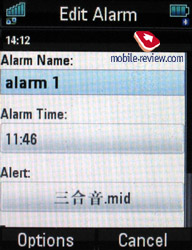 

In the last part of review we will look through the rest functions
as there are a lot of them; the main attention will be given to
musical abilities of the handset and its camera. We will also talk
about the record productivity of the handset.
Motorola ROKR E2.
The last part
Eldar Murtazin (eldar@mobile-review.com)
Translated by Kira Efimova (kira.efimova@mobile-review.com)
Published — 08 February 2006
Have something to add?! Write us... eldar@mobile-review.com
|














































































































































